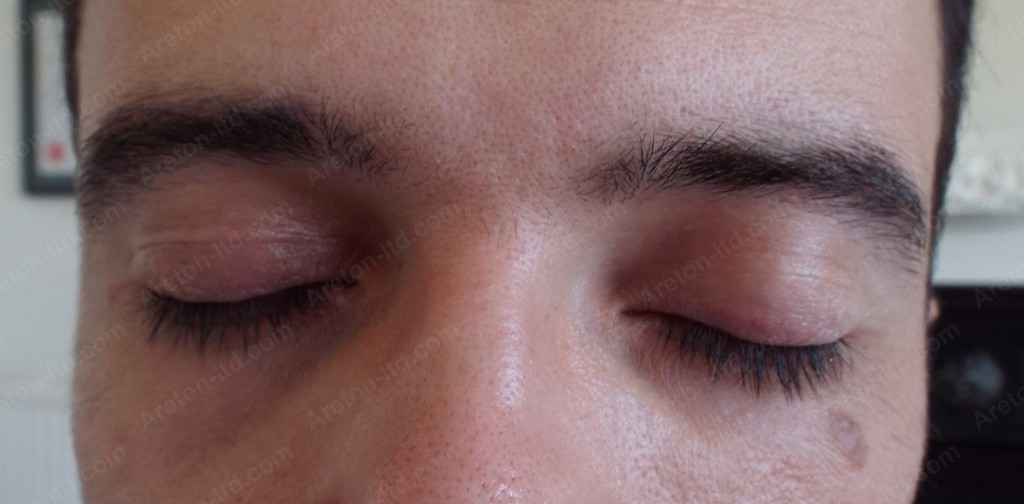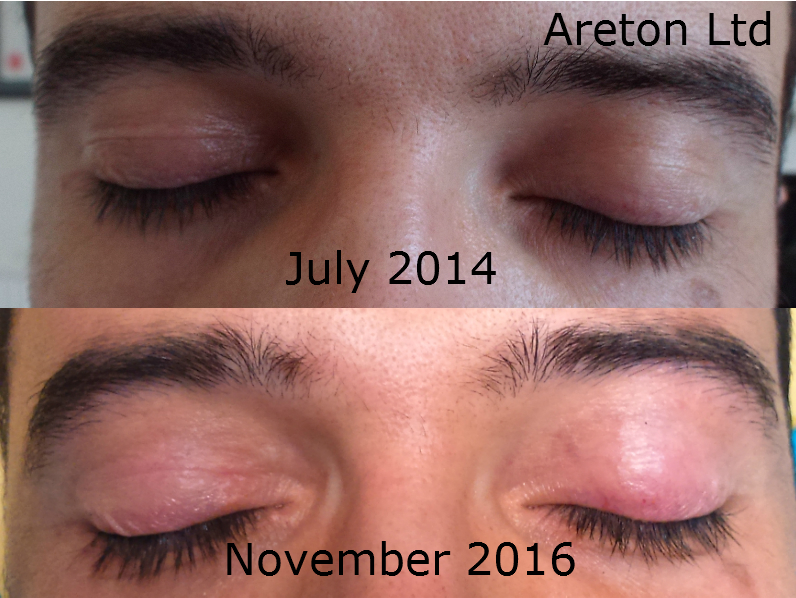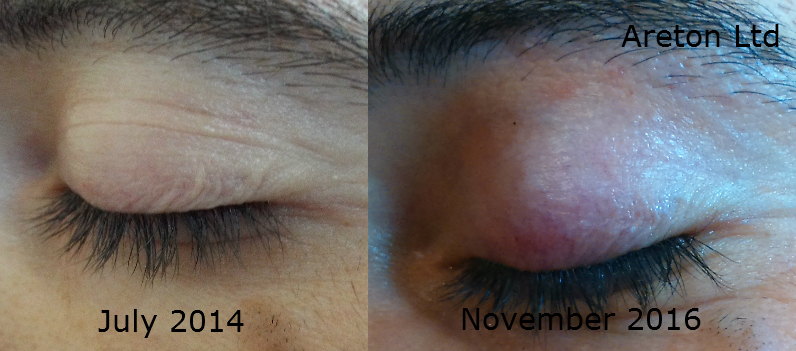[:en]
The subject presented in this case study is Andreas Russo, the Managing Director of Areton Ltd as 2016. The Due to his age (subject born in 1980) at the time of the plasma aesthetic treatment, the subject did not present a considerable amount of excess skin on the upper eyelid area, therefore he would have not been a suitable candidate for any type of surgical intervention in the first place.
The video Summary of this Case Study shows the spray skin tightening procedure carried out also using the spray operation. As you may know, usually the spot operation is used instead
You do not need to study all the whole content of this web-page in detail if you do not want. You can simply have an overview of the content of this case study by simply watching the video.
The length of the video at normal speed is 15 minutes, because it shows the treatment in its entirety. We have therefore edited a fast forwarded version only lasting 5 minutes. If you would like to watch the fast forwarded version please click here.
If after watching this video you would like to find out more about this case study you can continue reading the content of this web-page.
The subject presented in this case study is Andreas Russo, the Managing Director of Areton Ltd as 2016. The Due to his age (subject born in 1980) at the time of the plasma aesthetic treatment, the subject did not present a considerable amount of excess skin on the upper eyelid area, therefore he would have not been a suitable candidate for any type of surgical intervention in the first place.
However plasma eyelid tightening is deemed to be more suitable whenever there is little excess skin and the improvement sought is also only minor, like in this case.
- The technique used shown in this case study is the spray operation for localised skin tightening. As we will see, despite the fact that the spray operation can be more challenging it was put to the test in this case study not only to show its efficacy but also its safety too.
- The device used was the BeautyTeck, the setting was level 10 with 3 battery configuration. Relatively fast sweeping motions were applied.
If you have seen or studied voltaic plasma eyelid tightening treatments, you may have seen that the technique used is mostly the spot operation. The spot operation is extensively used for localised electrical plasma skin tightening because it is particularly easy to learn, perform and it leads to appreciable consistent results. Also as we have seen sometimes the two techniques can blend and become undistinguishable when the spots are applied very tightly together (please watch this video to see what we mean).
The main difference between the spot mode and the spray operation is that spray operation is generally more challenging to learn than the spot operation, and because of this, normally only very experienced aesthetic practitioners use it for localised skin tightening (in particular occasions only). Also there is no clear advantage in using the spray operation in localised skin tightening using Voltaic Plasma.
However, in this specific case, the subject of the case study explicitly requested to perform the spray operation on him. This was also done to show how the spray operation can have the same safety and efficacy as the spot mode. This also demonstrates how, even a non medically qualified person, trying out this type of treatment for the first time can carry out what is supposedly the most difficult technique, the spray operation in plasma localised skin tightening, while still leading not only to safety of the treatment but also good results.
While the spot operation is carried out by applying voltaic spots on the area to be treated, and the parameters to be varied are: only the spot duration, distance between the spots and power intensity of the device; on the other hand, the spray operation can be applied in several different ways by simply varying the speed of the sweeping motion. Furthermore, with the spray operation, it may not always be straightforward to appraise where you have already passed the voltaic spray, and where you have not. In other words, during the spray operation it is in not very easy to determine what part has been already covered by the voltaic arc already and what has not. Therefore this makes the spray operation more challenging technique to be learned than the spot operation.
As seen in the video, in the case presented, the spray operation was carried out by performing relatively fast sweeping motions. These motions can be varied in speed achieving very different results.
Since, at the time of the aesthetic procedure, the right eyelid presented the most loose skin, the treatment focused more on the right eyelid. As you can see in the video, the length of treatment carried out on the left upper eyelid is less than half compared to the right upper eyelid.
Two different people had performed the treatment under the direction of the subject undergoing the treatment. Both people performing the procedure did not hold any formal medical qualification, nor did they have prior hands on experience in performing these types of aesthetic treatment. They alternated the use of the device on both right and left eyelids.
In this case the operators were both beginners who never performed this type of treatments. This shows how common sense and care can lead to a safe treatment as well as good results.
However, as discussed earlier, generally the spray operation is not recommended for eyelid tightening because it is difficult to learn compared to the spot operation which has been extensively shown to achieve consistent good results.
The subject hardly experienced any pain during the Plasma aesthetic treatment this was mainly due to the use of a professional customised numbing product. Some degree of discomfort was experienced when the treatment was performed close to the eyelashes, where the topical numbing product could not be applied properly. The type of numbing product used becomes effective within a few minutes from the application, without the need to apply occlusion. To learn more about this product please visit this link.
The day following the procedure the subject rested until early afternoon without undertaking any professional activity. The subject was able to carry out all the normal working activities by late afternoon/evening of the day following the procedure.
The area was washed with Mild Neutral soap as normal, twice a day starting form the day following the treatment.
No antiseptics of any types were used by this particular subject. No ice packing were applied to soothe the area immediately after the treatment or during the healing. No soothing products or any creams were used at any point. Therefore the healing took place without the use of any products or drugs of any types.
It is also important to emphasise that the subject lived in parts of the world where the ultraviolet rays are relatively weak throughout the year (i.e. UK) and the treatments were carried out in winter time. Therefore the subject decided not to use sun screen at his own risk.
Please note that the use of total physical sun screen after healing is mandatory in any case for at least three months after the last treatment and sun exposure should be purposely avoided even while using sun protection. If the area is exposed to sun the sun too early even with the use of sun screen hyper-pigmentation could result.
This is the description provided by the subject:
"The burning sensation hit me as soon as the effect of the numbing products faded."
This means that there is an intense burning sensation on the area treated which takes over within 30 minutes to one hour immediately after the treatment.
"As this burning sensation begun the upper eyelids started to swell too. The swelling of the upper eyelids increased throughout the evening and night. The night after the treatment I had some trouble sleeping due to the burning sensation of the aesthetic procedure."
"The first night, before going to sleep after the treatment, when I put water on to the area treated and the area become really painful. The intense pain lasted a few minutes after I applied water onto it but faded quickly."
"The swelling of the upper eyelids peaked the morning after the treatment. I had trouble opening my eyes in the morning due to the swelling of the upper eyelids."
"Slowly through the morning the swelling stated to subside slightly so I could open my eyes. The pain and discomfort stated to subside throughout the day. By late afternoon I could open my eyes and in the evening I could carry out any normal activity."
"The second night the pain went away and was replaced by only a slight feeling of discomfort, so I had a very good night sleep. The second day, in the morning, I could almost open my eyes fully and the pain had gone and so the burning sensation which started to be replaced an itchy sensation. I could carry out any normal activities all thought the day. The third night I slept well as usual and I could not almost I had any treatment done while in bed."
Day 3. "I could open my eyes normally throughout the day. All swelling on the upper eyelid was gone. I had no more discomfort at all instead the itchy sensation increased. The scabs started to develop, so people could still notice I had some sort of treatment done on to my eyes."
Normally the itchy sensation starts 3 days after the treatment and only lasts only 10 to 15 days after each treatment.
Day 4. "The itchy sensation continued as the scabs stated to fall off on their own accord."
Day 5. "No one could tell I had any treatment done apart form the few people who could notice some of my remaining scabs."
Day 6. " All scabs fell off on their own accord and no body could notice I had any treatment done at all."
Day 7 onwards. "The are remained red and slightly itchy for a while. The itchy sensation lasted for two to three weeks approximately, however it subsided over time."
Two months later. "The redness disappeared completely 8 weeks after the treatment."
After the main healing process is over and the scabs have fallen off on their own accord, the area will still be red and generally slightly itchy. The treated area is subject to change over the period of 6 to 8 weeks. Also the area feels tenderer than the surrounding skin for at least 4 to 6 weeks after the treatment. During this period, while applying creams and sun protection, a slightly stinging sensation may be felt, this is normal.
The the treatment should not be repeated until the are has fully recovered also from the long term healing.
Several after pictures have been presented in order to allow a full comparison between the before and after the treatment. In this case the after pictures were taken well over one year after the last plasma eyelid tightening treatment. This allows any redness due to the treatment to have completely subsided. Also this subject underwent the removal of a benign lesion on the right eyelid a couple of months prior (in September 2016) to taking these "after" pictures in November 2016.
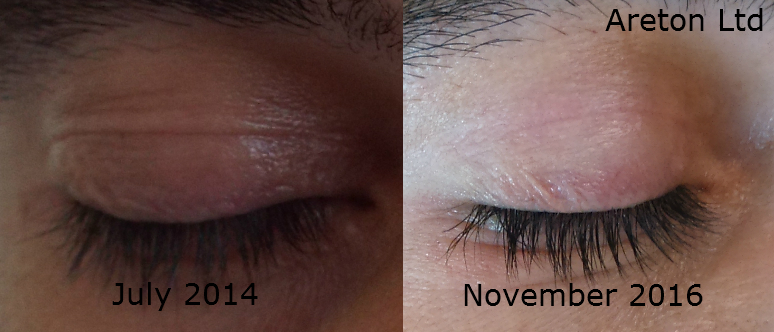
Frontal picture of the right Eyelid. This was the eyelid that underwent the benign skin lesion removal for aesthetic reasons in September 2016. As it is clear from the picture the improvement is evident.
The results shown are a comparison between the pictures taken before the first eyelid tightening treatment in July 2014 and the pictures taken before the last plasma upper eyelid tightening treatment performed in November 2016.
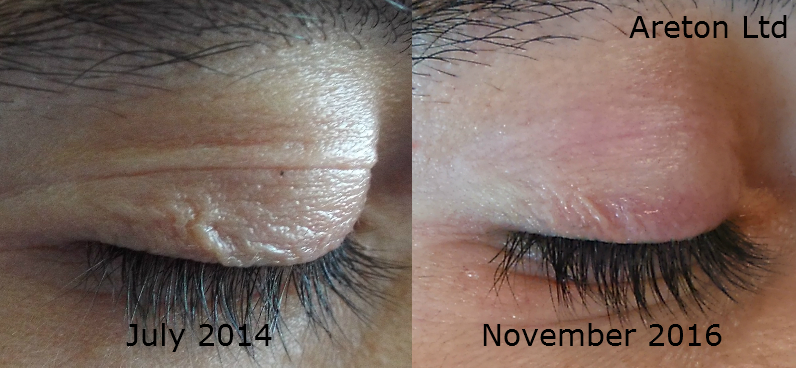
This picture also shows the improvement in the sighteniess of the eyelid. This is particularly noticeable in this picture.
Please note that we have published several pictures so that the comparison can be carried out also independently. Anyone is authorised to take the before and after pictures presented in this web-page and perform the same comparison presented here. The results will be the same or very similar despite the pictures used to compare the before and after side by side.
[:es]
El tema presentado en este estudio es Andreas Russo, Director General de Areton Ltd en 2016. Debido a su edad (sujeto nacido en 1980) en el momento del tratamiento estético con plasma, el sujeto no presentó una cantidad considerable de exceso. piel en el área del párpado superior, por lo tanto, no habría sido un candidato adecuado para ningún tipo de intervención quirúrgica en primer lugar.
El video Resumen de este estudio de caso muestra el procedimiento de estiramiento de la piel con barrido (Spray)realizado también utilizando la operación de barrido. Como usted puede saber, por lo general se utiliza la operación spoten su lugar
No necesita estudiar todo el contenido de esta página web en detalle si no lo desea. Simplemente puede tener una visión general del contenido de este estudio de caso simplemente viendo el vídeo.
La duración del video a velocidad normal es de 15 minutos, ya que muestra el tratamiento en su totalidad. Por lo tanto, hemos editado una versión de avance rápido de solo 5 minutos. Si desea ver la versión de reenvío rápido, haga clic aquí..
Si después de ver este vídeo desea obtener más información sobre este estudio de caso, puede continuar leyendo el contenido de esta página web.
El tema presentado en este estudio es Andreas Russo, Director General de Areton Ltd en 2016. Debido a su edad (sujeto nacido en 1980) en el momento del tratamiento estético con plasma, el sujeto no presentó una cantidad considerable de exceso. piel en el área del párpado superior, por lo tanto, no habría sido un candidato adecuado para ningún tipo de intervención quirúrgica en primer lugar.
Sin embargo, el estiramiento del párpado en plasma se considera más adecuado cuando hay poco exceso de piel y la mejora buscada es también menor, como en este caso.
- La técnica utilizada en este estudio de caso es la operacion barrido (Spray) para el estiramiento cutáneo localizado. Como veremos, a pesar del hecho de que la operación de barrido (Spray) puede ser más desafiante, se puso a prueba en este estudio no solo para demostrar su eficacia sino también su seguridad.
- El dispositivo utilizado fue el BeautyTeck, la configuración fue de nivel 10 con 3 configuraciones de batería. Se aplicaron movimientos de barrido relativamente rápidos.
Si ha visto o estudiado tratamientos voltaicos de estiramiento de párpados con plasma, es posible que haya visto que la técnica utilizada es principalmente la operación spot (punto). La operación spot se utiliza ampliamente para el estiramiento de piel localizada con plasma porque es particularmente fácil de aprender, de realizar y conduce a resultados constantes y apreciables. Además, como hemos visto a veces, las dos técnicas pueden combinarse y volverse indistinguibles cuando los puntos se aplican muy juntas ((por favor mire este video para ver lo qué queremos decir).).
La principal diferencia entre el modo spot y la operación de barrido (spray) es que la operación de spray generalmente es más difícil de aprender que la operación spot, y debido a esto, normalmente solo los profesionales de la estética muy experimentados lo usan para el estiramiento de la piel localizado (solo en casos particulares). Además, no existe una ventaja clara en el uso de la operación de spray en el estiramiento de la piel localizada con Plasma voltaico.
Sin embargo, en este caso específico, el sujeto del estudio solicitó explícitamente que le realizara la operación de barrido (spray). Esto también se hizo para mostrar cómo la operación spray puede tener la misma seguridad y eficacia que el modo spot. Esto también demuestra cómo, incluso una persona no cualificada médicamente, probar este tipo de tratamiento por primera vez puede llevar a cabo lo que supuestamente es la técnica más difícil, la operación spray en el estiramiento de piel localizada con plasma, mientras que no solo conduce a la seguridad del tratamiento, pero también buenos resultados.
Mientras que la operación spotse realiza aplicando puntos voltaicos en el área a tratar, y los parámetros a variar son: solo la duración del punto, la distancia entre los puntos y la intensidad de potencia del dispositivo; por otro lado, la operación spray se puede aplicar de varias maneras diferentes simplemente variando la velocidad del movimiento de barrido. Además, con la operación spray, puede que no siempre sea sencillo evaluar dónde ya ha pasado el rociado voltaico y dónde no lo ha hecho. En otras palabras, durante la operación spray no es muy fácil determinar qué parte ya ha sido cubierta por el arco voltaico y qué no. Por lo tanto, esto hace que la operación spray sea una técnica más difícil de aprender que la operación spot.
Como se ve en el video, en el caso presentado, la operación spray se llevó a cabo realizando movimientos de barrido relativamente rápidos. Estos movimientos pueden variar en velocidad logrando resultados muy diferentes.
Dado que, en el momento del procedimiento estético, el párpado derecho presentaba la piel más suelta, el tratamiento se centró más en el párpado derecho. Como puede ver en el video, la duración del tratamiento realizado en el párpado superior izquierdo es inferior a la mitad en comparación con el párpado superior derecho.
Dos personas diferentes habían realizado el tratamiento bajo la dirección del sujeto sometido al tratamiento. Las dos personas que realizaron el procedimiento no tenían ninguna calificación médica formal, ni tenían experiencia previa en la realización de este tipo de tratamiento estético. Alternaron el uso del dispositivo en los párpados derecho e izquierdo.
En este caso, los operadores fueron principiantes que nunca realizaron este tipo de tratamientos. Esto muestra cómo el sentido común y la atención pueden llevar a un tratamiento seguro, así como a buenos resultados.
Sin embargo, como se mencionó anteriormente, en general, la operación spray no se recomienda para apretar los párpados porque es difícil de aprender en comparación con la operación spot que se ha demostrado ampliamente para lograr buenos resultados consistentes.
El sujeto casi no experimentó ningún dolor durante el tratamiento estético con plasma, esto se debió principalmente al uso deun producto anestésico profesional personalizado. . Se experimentó cierto grado de incomodidad cuando el tratamiento se realizó cerca de las pestañas, donde el producto anestésico tópico no se pudo aplicar correctamente. El tipo de producto para adormecer usado se hace efectivo a los pocos minutos de la aplicación, sin la necesidad de aplicar oclusión. Para obtener más información sobre este producto, visiteeste enlace..
El día siguiente al procedimiento, el sujeto descansó hasta la tarde sin realizar ninguna actividad profesional. El sujeto pudo realizar todas las actividades normales de trabajo al final de la tarde / noche del día siguiente al procedimiento.
El área se lavó con jabón suave neutro como de costumbre, dos veces al día a partir del día siguiente al tratamiento.
Ningún antiséptico de ningún tipo fue utilizado por este sujeto en particular. No se aplicaron bolsas de hielo para calmar el área inmediatamente después del tratamiento o durante la curación. No se utilizaron productos calmantes ni cremas en ningún momento. Por lo tanto, la curación tuvo lugar sin el uso de ningún producto o medicamento de ningún tipo.
También es importante enfatizar que el sujeto vivió en partes del mundo donde los rayos ultravioleta son relativamente débiles durante todo el año (es decir, el Reino Unido) y los tratamientos se llevaron a cabo en invierno. Por lo tanto, el sujeto decidió no usar protector solar bajo su propio riesgo.
Tenga en cuenta que el uso de la pantalla solar física total después de la curación es obligatorio en cualquier caso durante al menos tres meses después del último tratamiento y la exposición al sol debe evitarse deliberadamente, incluso cuando se usa protección solar. Si el área se expone al sol, puede producirse el sol demasiado pronto, incluso con el uso de una pantalla de protección solar.
Esta es la descripción proporcionada por el sujeto:
"La sensación de ardor me golpeó tan pronto como el efecto de los productos anestésicos se desvaneció".
Esto significa que hay una intensa sensación de ardor en el área tratada que oscila entre 30 minutos a una hora inmediatamente después del tratamiento.
"Cuando comenzó esta sensación de ardor, los párpados superiores también se hincharon. La hinchazón de los párpados superiores aumentó durante la noche. "La noche después del tratamiento tuve algunos problemas para dormir debido a la sensación de ardor del procedimiento estético".
"La primera noche, antes de irme a dormir después del tratamiento, cuando pongo agua en el área tratada y el área se vuelve muy dolorosa. El dolor intenso duró unos minutos después de haber aplicado agua pero se desvaneció rápidamente".
"La hinchazón de los párpados superiores alcanzó su punto máximo la mañana después del tratamiento. Tuve problemas para abrir los ojos por la mañana debido a la hinchazón de los párpados superiores".
"Lentamente a lo largo de la mañana, la hinchazón disminuyó levemente para que pudiera abrir los ojos. El dolor y la incomodidad disminuyeron a lo largo del día. A última hora de la tarde podía abrir los ojos y por la noche podía realizar cualquier actividad normal".
"La segunda noche, el dolor desapareció y fue reemplazado por una leve sensación de incomodidad, por lo que tuve una buena noche de sueño. El segundo día, por la mañana, casi pude abrir los ojos por completo y el dolor había desaparecido, y así "La sensación de ardor que comenzó a ser reemplazada por una sensación de picazón. Podía realizar cualquier actividad normal todo el día. La tercera noche dormí bien como de costumbre y casi no pude hacerme ningún tratamiento mientras estaba en la cama".
Día 3. "Podía abrir mis ojos normalmente a lo largo del día. Toda la hinchazón en el párpado superior había desaparecido. No sentí más incomodidad en su lugar, la sensación de picazón aumentó. Las costras comenzaron a desarrollarse, por lo que la gente todavía podía notar que tenía algo de dolor. Tipo de tratamiento hecho en mis ojos ".
Normalmente, la sensación de picazón comienza 3 días después del tratamiento y solo dura entre 10 y 15 días después de cada tratamiento.
Día 4. "La sensación de picazón continuó mientras las costras decían que se caían por su propia cuenta".
Día 5. "Nadie podía decir que me habían hecho un tratamiento aparte de las pocas personas que podían notar algunas de mis costras restantes".
Día 6. "Todas las costras se cayeron por sí mismas y ningún cuerpo pudo notar que me hicieron algún tratamiento".
Día 7 en adelante. "Se mantuvieron enrojecidos y con un poco de picazón por un tiempo. La sensación de picazón duró de dos a tres semanas aproximadamente, sin embargo disminuyó con el tiempo".
Dos meses despues. "El enrojecimiento desapareció completamente 8 semanas después del tratamiento".
Después de que el proceso principal de curación haya terminado y las costras se hayan caído por su propia cuenta, el área seguirá siendo roja y generalmente con un poco de picazón. El área tratada está sujeta a cambios durante el período de 6 a 8 semanas. Además, el área se siente más sensible que la piel circundante durante al menos 4 a 6 semanas después del tratamiento. Durante este período, mientras se aplican cremas y protección solar, se puede sentir una sensación de picazón, esto es normal..
El tratamiento no debe repetirse hasta que se haya recuperado completamente también de la curación a largo plazo.
Se han presentado varias imágenes posteriores para permitir una comparación completa entre el antes y el después del tratamiento. En este caso, las fotografías posteriores se tomaron más de un año después del último tratamiento de estiramiento del párpado con plasma. Esto permite que cualquier enrojecimiento debido al tratamiento haya desaparecido completamente. También este sujeto se sometió a la extirpación de una lesión benigna en el párpado derecho un par de meses antes (en septiembre de 2016) para tomar estas fotografías "posteriores" en noviembre de 2016.

Imagen frontal del párpado derecho. Este fue el párpado que se sometió a la remoción de lesiones cutáneas benignas por razones estéticas en septiembre de 2016. Como queda claro en la imagen, la mejora es evidente.
Los resultados que se muestran son una comparación entre las fotografías tomadas antes del primer tratamiento de estiramiento de párpados en julio de 2014 y las fotografías tomadas antes del último tratamiento de estiramiento de párpados con plasma realizado en noviembre de 2016.

Esta imagen también muestra la mejora en la vista del párpado. Esto es particularmente notable en esta imagen.
Tenga en cuenta que hemos publicado varias imágenes para que la comparación se pueda realizar de forma independiente. Cualquier persona está autorizada para tomar las fotos de antes y después presentadas en esta página web y realizar la misma comparación que se presenta aquí. Los resultados serán los mismos o muy similares a pesar de las imágenes utilizadas para comparar el antes y el después de lado a lado.
[:]

